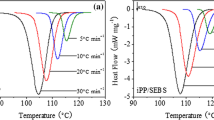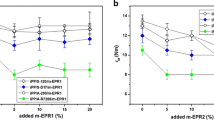Abstract
The influence of molecular weight on the mechanical properties of isotactic poly(propylene) (iPP) and iPP blended with ethylene-propylene copolymers has been investigated by means of the microhardness technique. The hardness (H) of iPP is shown to slightly decrease with increasing molecular mass, within the range of molecular weights investigated. The H-decrease is correlated to a loss of crystallinity as the average molecular weight increases. On annealing, the mechanical properties are enhanced as a consequence of an increase in both, the degree of crystallinity and the crystalline lamellar thickness. A value of H ∞ c for iPP crystals of infinite thickness in the α-form is proposed for the first time. The inclusion of EPR particles in the iPP matrix softens the material. This result could be explained in terms of an increase in the basal surface free energy of the iPP crystals with increasing amount of rubber content.
Similar content being viewed by others
Author information
Authors and Affiliations
Additional information
Received: 2 February 1998 Accepted: 11 May 1998
Rights and permissions
About this article
Cite this article
Flores, A., Aurrekoetxea, J., Gensler, R. et al. Microhardness-structure correlation of iPP/EPR blends: influence of molecular weight and EPR particle content. Colloid Polym Sci 276, 786–793 (1998). https://doi.org/10.1007/s003960050311
Issue Date:
DOI: https://doi.org/10.1007/s003960050311




